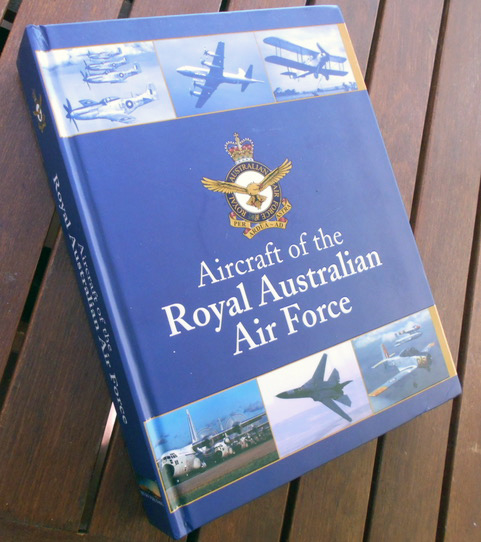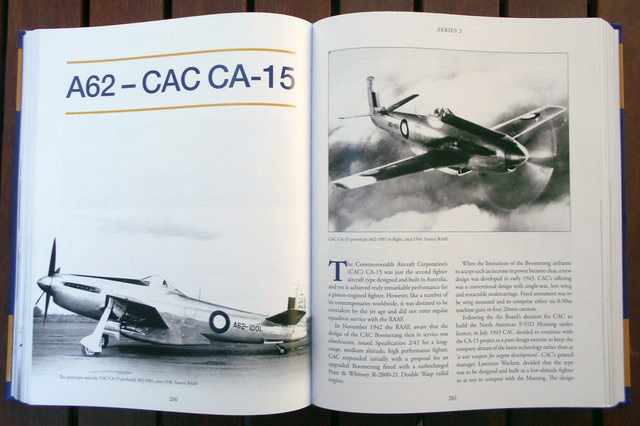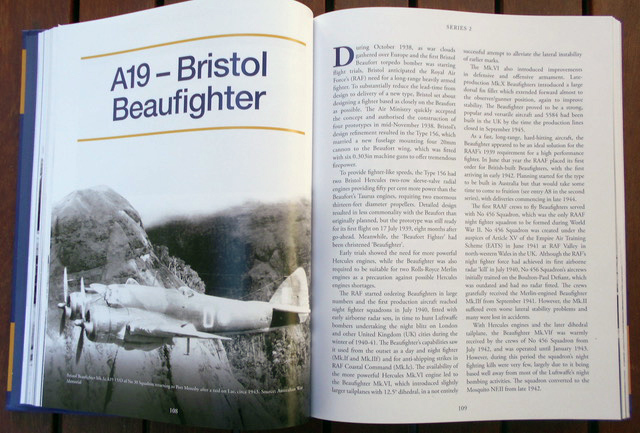Aircraft of the Royal Australian Air Force

Big Sky Publishing
S u m m a r y |
Title and Publisher |
Aircraft of the Royal Australian Air Force
Commonwealth of Australia
Big Sky Publishing
2021 |
| ISBN: |
Not Quoted |
Contents and Media: |
609 A4 pages of text and a 23-page set of introductory sections, all printed on quality semi-gloss paperR. |
Price: |
RP around AUD$60.00 at book shops and online |
Review Type: |
FirstLook |
Advantages: |
A complete record of all the aircraft types that served in the RAAF since 1921 and an invaluable source of information and comparative data, beautifully presented and sequenced. |
Disadvantages: |
None noted. |
Conclusion: |
This is an excellent compendium on the aircraft that have served the RAAF since its inception a century ago and I would highly commend it to anyone interested in this air force as it brings together a mass of information that you would need a lot of time to find through other means. This should be on every modeller’s coffee table or in their library. |
Reviewed by Graham Carter

This monumental work, the result of several years of toil by a large group of aircraft and history experts in the RAAF History and Heritage section, has been released to commemorate the centenary of the formation of the RAAF in 1921, becoming only the second country in the world, after Great Britain, to have a separate air force.
Strongly case-Bound in royal blue heavy card with an embossed RAAF crest on the front, there are 609 A4 pages of text and a 23-page set of introductory sections, all printed on quality semi-gloss paper that allows excellent photo reproduction in both B&W and colour. The price of all this material is that the book weighs a hefty 2750g, that’s just over six pounds for those of you living in the avoirdupois world! Falling asleep in bed or armchair with this on your chest could result in serious injury - ha ha!
What wonderful compendium it is. Starting with a Table of Contents, there follows a Foreword from Chief of Air Force, Air Marshal Mel Hupfield , AO, DSC, and an Introduction. Then a complete list of aircraft types by A-Series numbers with a following explanation of the system used to identify aircraft in the RAAF, including the three A-Series systems and the manner in which these were allocated to specific types. It is here, for example we learn why the F4 Phantom has an ‘A’ number way out of sequence. The initial section concludes with a massive list of Acronyms and Abbreviations.
The three sections that follow contain the ‘meat’ of this book. Starting with Series 1 and A1, the DH 9A in 1921, we are informed about each aircraft type that served in the RAAF, all one hundred and fifty, or so, of them. The book aims to “describe the acquisition, operation and service record” of each type and “features a narrative, a table of dimensions and performance data and at least one image”, often more, drawn from private and official sources, many of them not seen by this reviewer before ( quoted from the Introduction, pages VI and VII). Photos are all of a good size and well-reproduced.
The First Series was made up of twelve types from the DH 9A to the Bristol Bulldog, with two serials being allocated to non-service aircraft and re-allocated. This was the case with A5 which was the Vickers Vimy but used for the Westland Wapiti and A11 when the Felixstowe F5 was not used so it went to the Supermarine Southhampton I.
The Second Series began in 1934 with A1 Hawker Demon, and ran through the war years and later, to A100, the DHC Otter. It is interesting to read of serials that were allocated to single examples such as the Vickers Viking and dH Sea Hornet or to aircraft that never made it into service such as A76 Avro Tudor and A86 Hawker P.1080, but which were re-allocated to the Boeing Washington or never used, respectively. It is in this section that one of our own Hyperscale contributors played a part with the section on A62, the CAC CA-15.

I was also delighted to see the header photo for A19, the British-built Beaufighter, which showed A19-15 ‘O’ piloted by F/O Bob Brazenor, with the smiling face of my old friend Fred Anderson m.i.d. in the rear cupola. Fred passed away last year at the age of 99 and was the last surviving RAAF aircrewman from the Battle of the Bismarck Sea. The Aussie-built Beaufighter had been ordered earlier, hence their A8 serial range.

Interestingly A13 was not allocated to a flying aircraft, but to the definitely ground-based Link Trainer! Superstition runs deep the your life depends on it I guess! And the same occurred with the Third Series where again A13 was allocated to the Link Trainer. The latest series began in 1960 with A1 Bell Sioux which served the Army under RAAF auspices. This is the current series and is expected to last for many decades to come at the present rate of acquisition as the RAAF is only up to A57. We also find the advent of colour images for most of these aircraft as distinct from the B&W images of earlier series examples. All images are reproduced to a good size and excellent quality. Several serials are allocated to aircraft that did/do not serve with the RAAF but with the Navy, Army or specialist users such as the Defence Science and Technology Group, some of which have ’N’ serials. These are understandably not treated in this book, hence you will not find the Sikorsky Sea Hawk, the NHI Taipan, Eurocopter Tiger or Bell Global Ranger in here. I found it particularly interesting to see the arrival of UAVs such as A45, the IAI Heron and A57, Northrop Grumman Triton. This section concludes with the well out-of-sequence A69, McDonnell Douglas F-4E Phantom.
There is then a comprehensive eight-page Index, another six pages of reference books and other sources and two pages of acknowledgements, both individual and corporate. The former include several members of modelling clubs and associations here in Australia.
All-in-all, this is an excellent compendium on the aircraft that have served the RAAF since its inception a century ago and I would highly commend it to anyone interested in this air force as it brings together a mass of information that you would need a lot of time to find through other means. This volume is a credit to the labours of the large team of contributors and co-ordinators who I know have worked on it for several years, especially during the lock-down period in 2020.
Purchased by the reviewer

Review Text and Images Copyright © 2021 by Graham Carter
This Page Created on 28 April, 2021
Last updated
28 April, 2021
Back to HyperScale Main Page
|
